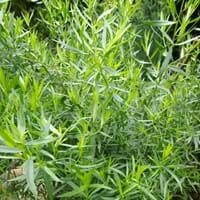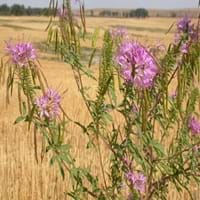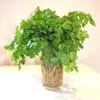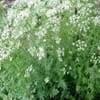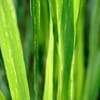Type
Herbs
Herbs, Vegetable
Origin
Western United States, Canada, Europe, Eastern Europe, Russia/Siberia
South America, Argentina, Brazil
Types
not available
Skunk weed, Navajo spinach
Habitat
Fields, meadows
foothill woods, open Woodlands, Prairies, Roadsides
USDA Hardiness Zone
4-9
3-10
Sunset Zone
A1, A2, A3, 2b, 3a, 3b, 4, 5, 6, 7, 8, 9, 10, 14, 15, 16, 17, 18, 19, 20, 21, 22, 23, 24
1a, 1b, 2a, 2b, 3a, 3b, 4, 5, 6, 7, 8, 9, 10, 11, 12, 13, 14, 15, 16, 17, 18, 19, 20, 21, 22, 24
Habit
Clump-Forming
Upright/Erect
Flower Color
White, Yellow
White
Flower Color Modifier
Bicolor
Bicolor
Fruit Color
Not Available
Green
Leaf Color in Spring
Light Green
Green
Leaf Color in Summer
Light Green
Green
Leaf Color in Fall
Light Green
Green
Leaf Color in Winter
Light Green
Light Green
Leaf Shape
Lobed
Small elliptic
Plant Season
Spring, Summer, Fall
Summer
Sunlight
Full Sun
Full Sun
The pH of Soil
Neutral
Acidic, Neutral
Soil Drainage
Well drained
Well drained
Bloom Time
Early Summer, Summer
Summer, Late Summer
Tolerances
Drought
Cold climate
Where to Plant?
Ground
Container, Ground
How to Plant?
Cuttings, Divison, Seedlings
Seedlings
Plant Maintenance
Medium
Low
Watering Requirements
Medium
Medium, Requires regular watering, Requires watering in the growing season, Water occasionally
In Summer
Lots of watering
Lots of watering
In Spring
Moderate
Moderate
In Winter
Average Water
Average Water
Soil pH
Neutral
Neutral, Slightly Acidic
Soil Type
Loam
Sandy, Well drained
Soil Drainage Capacity
Well drained
Sandy, Well drained
Sun Exposure
Full Sun
Full Sun
Pruning
Remove damaged leaves, Remove dead branches, Remove dead leaves
Remove damaged leaves, Remove dead or diseased plant parts
Fertilizers
All-Purpose Liquid Fertilizer
All-Purpose Liquid Fertilizer, fertilize in growing season
Pests and Diseases
Red blotch
Insects, Leaf spot
Plant Tolerance
Drought
Cold climate
Flowers
Insignificant
Showy
Flower Petal Number
Single
Single
Fragrant Bark/Stem
Yes
Yes
Foliage Texture
Medium
Medium
Foliage Sheen
Glossy
Matte
Attracts
Butterflies
Bees, Butterflies
Allergy
Not Available
Not Available
Aesthetic Uses
Showy Purposes
Landscape Designing
Beauty Benefits
Not Available
Not Available
Environmental Uses
Air purification
Air purification, Food for insects, Shelter for wildlife
Medicinal Uses
Anti-oxidant, Appetizer, Digestion problems, Eye Problems, Sedative, Tooth ache
Fever
Part of Plant Used
Leaves
Flowers, Leaves, Seeds
Other Uses
Culinary use, Traditional medicine
Decoration Purposes, Making deodorants, Used as a dye, Used As Food, Used for its medicinal properties
Used As Indoor Plant
Insignificant
Yes
Used As Outdoor Plant
Yes
Yes
Garden Design
Container, Edible, Herb / Vegetable
Edible, Herb
Botanical Name
ARTEMISIA dracunculus
CLEOME hassleriana 'Helen Campbell'
Common Name
French Tarragon
Cleome, Spider Flower
In Hindi
ARTEMISIA dracunculus
Cleome serrulata
In German
ARTEMISIA dracunculus
Cleome serrulata
In French
ARTEMISIA dracunculus
Cleome serrulata
In Spanish
ARTEMISIA dracunculus
serrulata cleome
In Greek
ARTEMISIA dracunculus
Cleome serrulata
In Portuguese
ARTEMISIA dracunculus
serrulata Cleome
In Polish
ARTEMISIA dracunculus
cleome serrulata
In Latin
ARTEMISIA dracunculus
Cleome serrulata
Phylum
Tracheophyta
Magnoliophyta
Class
Magnoliopsida
Magnoliopsida
Order
Asterales
Brassicales
Family
Asteraceae
Cleomaceae
Clade
Angiosperms, Asterids, Eudicots
Angiosperms, Eudicots, Rosids
Tribe
Not Available
Not Available
Subfamily
Not Available
Not Available
Number of Species
Not Available
Not Available
Season and Care of French Tarragon and Cleome serrulata
Season and care of French Tarragon and Cleome serrulata is important to know. While considering everything about French Tarragon and Cleome serrulata Care, growing season is an essential factor. French Tarragon season is Spring, Summer and Fall and Cleome serrulata season is Spring, Summer and Fall. The type of soil for French Tarragon is Loam and for Cleome serrulata is Sand while the PH of soil for French Tarragon is Neutral and for Cleome serrulata is Acidic, Neutral.
French Tarragon and Cleome serrulata Physical Information
French Tarragon and Cleome serrulata physical information is very important for comparison. French Tarragon height is 30.50 cm and width 25.40 cm whereas Cleome serrulata height is 120.00 cm and width 120.00 cm. The color specification of French Tarragon and Cleome serrulata are as follows:
French Tarragon flower color: White and Yellow
French Tarragon leaf color: Light Green
Cleome serrulata flower color: White
- Cleome serrulata leaf color: Green
Care of French Tarragon and Cleome serrulata
Care of French Tarragon and Cleome serrulata include pruning, fertilizers, watering etc. French Tarragon pruning is done Remove damaged leaves, Remove dead branches and Remove dead leaves and Cleome serrulata pruning is done Remove damaged leaves and Remove dead or diseased plant parts. In summer French Tarragon needs Lots of watering and in winter, it needs Average Water. Whereas, in summer Cleome serrulata needs Lots of watering and in winter, it needs Average Water.
